Introduction
Here are some examples of exercises for you to try. The exercises may be suggested for a condition or for rehabilitation. Start each exercise slowly. Ease off the exercises if you start to have pain.
You will be told when to start these exercises and which ones will work best for you.
How to do the exercises
Calf stretch (back knee straight)
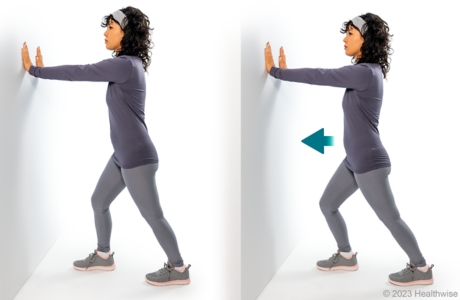
slide 1 of 7
slide 1 of 7, Calf stretch (back knee straight),
- Stand facing a wall with your hands on the wall. You can also do this with your hands on the back of a chair, a counter, or a tree.
- Put one leg about a step behind your other leg, with your toes pointing forward.
- Keeping your back leg straight and your back heel on the floor, bend your front knee and gently bring your hip and chest toward the wall until you feel a stretch in the calf of your back leg.
- Hold the stretch for 15 to 30 seconds.
- Repeat 2 to 4 times for each leg.
Calf stretch (both knees bent)
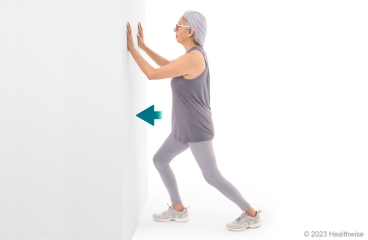
slide 2 of 7
slide 2 of 7, Calf stretch (both knees bent),
- Stand facing a wall with your hands on the wall. You can also do this with your hands on the back of a chair, a counter, or a tree.
- Put one leg about a step behind your other leg, with your toes pointing forward.
- Keeping both heels on the floor, bend both knees. Then gently bring your hip and chest toward the wall until you feel a stretch in the calf of your back leg.
- Hold the stretch for 15 to 30 seconds.
- Repeat 2 to 4 times for each leg.
Calf stretch (bilateral, knees straight)
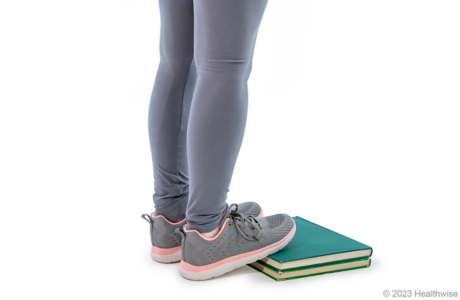
slide 3 of 7
slide 3 of 7, Calf stretch (bilateral, knees straight),
- Place a book on the floor a few inches from a wall or counter, and put the balls of your feet on it. Your heels should be on the floor. The book needs to be thick enough so that you can feel a gentle stretch in your calf. If you are not steady on your feet, hold on to a chair, counter, or wall while you do this stretch.
- Keep your knees straight, and lean forward until you feel a stretch in your calf.
- To get more stretch, add another book or use a thicker book.
- Hold the stretch for 15 to 30 seconds.
- Repeat 2 to 4 times.
Calf stretch (bilateral, knees bent)
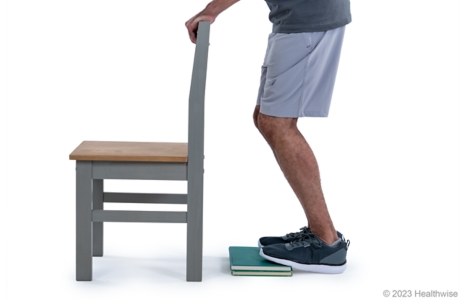
slide 4 of 7
slide 4 of 7, Calf stretch (bilateral, knees bent),
- Place a book on the floor, and put the balls of your feet on it. Your heels should be on the floor. The book needs to be thick enough so that you can feel a gentle stretch in your calf. If you are not steady on your feet, put the book a few inches from a chair, counter, or wall that you can hold onto as you do this stretch.
- Bend your knees, and lean forward until you feel a stretch in your calf.
- To get more stretch, add another book or use a thicker book.
- Hold the stretch for 15 to 30 seconds.
- Repeat 2 to 4 times.
Ankle plantar flexion
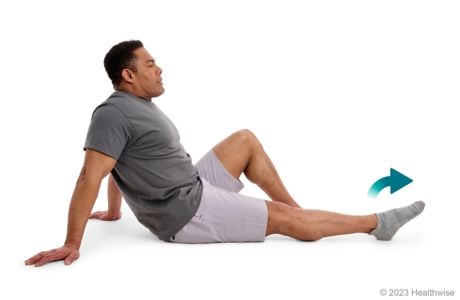
slide 5 of 7
slide 5 of 7, Ankle plantar flexion,
- Sit with your affected leg straight and resting on the floor. Your other leg should be bent, with that foot flat on the floor.
- Keeping your affected leg straight, gently flex your foot downward so your toes are pointed away from your body. Then slowly relax your foot to the starting position.
- Repeat 8 to 12 times.
- It's a good idea to repeat these steps with your other foot.
Ankle dorsiflexion
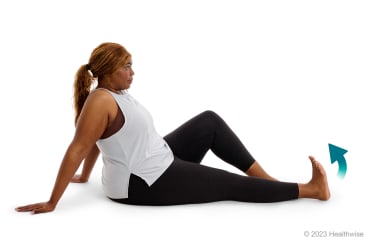
slide 6 of 7
slide 6 of 7, Ankle dorsiflexion,
- Sit with your affected leg straight and supported on the floor. Your other leg should be bent, with that foot flat on the floor.
- Keeping your leg straight, gently flex your foot back so your toes point upward. Then slowly relax your foot to the starting position.
- Repeat 8 to 12 times.
- It's a good idea to repeat these steps with your other leg.
Heel raise on a step

slide 7 of 7
slide 7 of 7, Heel raise on a step,
- Stand on the bottom step of a staircase, facing up toward the stairs. Put the balls of your feet on the step. If you are not steady on your feet, hold on to the handrail or wall.
- Keeping both knees straight, slowly lift your heels above the step so that you are standing on your toes. Then slowly lower your heels below the step and toward the floor.
- Return to the starting position, with your feet even with the step.
- Repeat 8 to 12 times.
Current as of: July 17, 2023
Author: Healthwise Staff
Clinical Review Board
All Healthwise education is reviewed by a team that includes physicians, nurses, advanced practitioners, registered dieticians, and other healthcare professionals.

